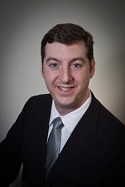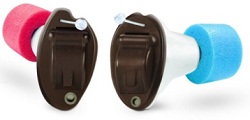Spontaneous Acceptance with Hearing Instruments - Introducing Siemens XCEL
CAROLYN SMAKA: Eric and Alina, thank you for your time today. There have been a lot of new product launches at Siemens recently. Can you give an overview?
Alina Urdaneta
ALINA URDANETA: It would be our pleasure. As you know, a couple of years ago we launched BestSound™ Technology, and it quickly became a new standard in audiological platforms. Building upon BestSound we recently launched a new technology called XCEL. As an audiologist, you know that patients sometimes leave a hearing aid fitting thinking, "Oh wow, this sounds a little bit tinny. This sounds a little bit metallic." Being a hearing aid user myself, I have experienced that, too. We try and restore maximum audibility, and we use prescriptive formulas to get us there, in order to try and provide better hearing. That's what we are trained to do, and that's what manufacturers have designed their products to do. Patients may have good speech intelligibility which is a main objective, but sometimes sound comfort would get sacrificed in the process.
With XCEL, we're excited to launch a technology where you don't have to compromise one or the other; it achieves a perfect balance between audibility and sound comfort. We have coined a new term, Soundability, for sound comfort and audibility.
SMAKA: Which products are available on the XCEL platform?
URDANETA: Our most popular products are available on the XCEL platform including Pure® and Pure® Carat, which have been extremely popular, especially here in the U.S. The Motion products, Motion® SX and Motion® P, which are designed for people with more severe hearing loss, are also on XCEL. And we have a brand new CIC - a very, very tiny CIC called Eclipse™ that runs on XCEL. It's a deep-fit product that is almost invisible when worn, and it's extremely comfortable - not only from a physical standpoint but also from an audiological standpoint, as we've been discussing. I'm going to let Eric elaborate on how we achieve soundability with XCEL.
Eric Branda
ERIC BRANDA: The idea behind achieving Soundability with XCEL is almost a play on words, accelerated acceptance. As Alina indicated, we are aiming for acceptance from the very start. We want it to sound good because we know you don't get a second chance to make a first impression. Whether the wearer is new to hearing instruments or has worn them previously, the first experience should be positive, and the instruments should sound good from the first exposure. There are three components in XCEL that are responsible for achieving accelerated acceptance and also keeping in mind the goal of delivering long-term satisfaction. Those three components are XCEL-Amp, XCEL-Fit and XCEL-View.
XCEL-Amp is an expanded compression system, where we are working with a second compression kneepoint and compression ratio. If you consider a standard compression system, you have straight linear gain up to the kneepoint and then compression gain thereafter. Such a system is good for soft sounds and good for loud sounds, but it doesn't give you a lot of flexibility for speech without compromising here or there. Speech is very dynamic with a lot of fluctuation in intensity. By adding a second kneepoint, you have linear gain, some compression after the first kneepoint, and then you can compress it again for a different level. This provides a nice balance for loud sounds, soft sounds and most importantly for speech, without making compromises.
One key component in this system is the second compression kneepoint and ratio. The other important component in XCEL-Amp is the time constants of the system. In the literature, you'll find studies supporting both fast attack/fast release times and slower attack/release times.
Fast attack/fast release times, or a syllabic type of compression, is typically associated with better intelligibility, because it ensures consonant sounds will get fully amplified, while vowel sounds will bring the system back down. Slower time constants are often associated with better sound quality, because the compression system is not constantly jumping in and out of compression. With slower time constants, you've got a nice flow and the differences between the levels are maintained resulting in a better sound quality. However, if louder low frequency sounds start to influence a slow system by sending it into compression, it can affect intelligibility, and so there's a compromise. Therefore, what we're doing is going with the slow time constants to ensure a good sound quality, but doing it smarter. That is, we know that in a multichannel system, channels work together. In XCEL-Amp, the surrounding channels have less influence on adjacent channels when they are lower frequency. Therefore, if you look at a central channel, we know that adjacent channels will always influence it. With XCEL Amp, that influence is asymmetrical; lower frequency channels have less influence on the central channel than higher frequency ones. This helps prevent the upward spread of masking so that intelligibility is maintained, yet we have good sound quality. That is XCEL-Amp
XCEL-Fit is a fitting algorithm looking for that balance between intelligibility and comfort. First, it considers some psychoacoustic measures for sound quality and sound comfort, and it also looks at effective audibility for intelligibility.
SMAKA: Can you go into a little more detail, such as what psychoacoustic measures it is looking at?
BRANDA: Sure. In terms of psychoacoustic measures, we looked at the research to see what's important for sound comfort, especially for comfort of speech. We needed to keep that in mind when we looked at effective audibility. We know that in general, with an increase in gain you get an improvement in speech intelligibility, and then you hit a peak. After the peak, increasing gain does not provide any further benefit in speech intelligibility. For example, when you watch TV and the volume is too low, you turn it up until you can hear it comfortably and understand what is being said. Someone else may come into the room and turn it louder. Maybe now you're not understanding any better, as it sounded fine before; it's just louder. In this case, sound quality has gone down and intelligibility hasn't gone up. If you look at average effective audibility levels, we can take the audiogram and then start to predict where a good range will be while maintaining sound quality, before getting that tinny, artificial sound. In doing so, we maintain a good sound quality without compromising on intelligibility.
XCEL-Fit provides satisfaction right away, and we've had great responses from both patients and hearing care professionals with this algorithm. We also know that over time, wearers may start to appreciate more amplification, and so we also have to keep long-term satisfaction in mind. This is where XCEL-View comes into play.
XCEL-View lets us achieve that more easily. In the fitting software, we can use an output view to look at what's really coming out of the instrument toward the eardrum. And now we'll look at where the hearing thresholds are, as well as where the UCL is in order to see the full dynamic range. Based on that audiogram, where is the guideline for effective audibility? With XCEL-View, we're looking at different targets in terms of the guideline for effective audibility. If we start to go above the average effective audibility for a loss, we may not be getting the benefit. When you are finetuning for long-term satisfaction, XCEL-View provides another guideline for programming.
SMAKA: Eric, if someone was using equipment like a Verifit for verification, how would they verify XCEL-Fit?
BRANDA: We know that probe mic verification is important, and this being a proprietary algorithm, it obviously wouldn't be available in Verifit or other probe mic equipment. What I encourage professionals to do, however, is to conduct probe microphone measurements to see where soft, average and loud sounds fall and to see how this algorithm differs from the algorithm you typically use for your fittings. You can ensure you are not exceeding UCL, and you'll know exactly what that patient is getting in terms of SPL.
SMAKA: Right. And if you do make changes down the road, you'll have a baseline.
BRANDA: Exactly, it's just good audiology.
SMAKA: Thanks for explaining XCEL, can we talk about Eclipse? Is it custom?
BRANDA: Yes, Eclipse is a custom, deep-fitting, extremely small CIC.
As you know, in addition to the cosmetic benefits of a deep-fitting device, we also have an advantage in terms of the occlusion effect. One way to reduce or alleviate the occlusion effect is with venting, but with these tiny instruments there is no room for adequate venting. Alternately, we can get down deeper into the ear canal, to the bony portion, where we know we've reduced or eliminated the occlusion effect.
Traditionally, we've talked about deep fitting for years, but no one is really achieving a true deep fitting for two reasons. The first one is comfort. It has not been comfortable to wear a device in that sensitive area deep in the canal. Secondly, the hearing care professional may not be comfortable with the risks of deep impressions. They don't want to place the otoblock close to the eardrum, and then fill the canal with impression material. These have been the two main barriers to truly deep fittings, both of which we have addressed with Eclipse.
First, you'll see on the instrument itself that we have a soft, pliable dome. This dome
is an added piece that attaches using our click technology that we developed originally for our RIC devices. It is a very secure connection.
Eclipse is an extremely small, deep-fitting CIC that virtually eliminates the occlusion effect and has the added benefit of XCEL technology.
SMAKA: Ah, I thought it was a sleeve that slipped over the device. Now I understand.
BRANDA: While the Eclipse hearing aid is built as a custom instrument, it has a receiver that this dome clicks on to. This enables it be soft and comfortably seated deeply in the ear canal. And, by having a removable, exchangeable dome there is now wax protection on the receiver and a second wax protection with the dome to help reduce or eliminate wax issues.
Eclipse XCEL features soft, pliable domes for a comfortable fitting that are secured to the instrument using click technology.
To make it even easier for the professional to take the impression, we've taken another foam dome with a flange to use in place of an otoblock. The dome is placed at the second bend, and when the impression material is inserted, it wraps around the flange on the back side so that the dome now becomes part of the impression. You now have used the dome in place of an otoblock to your advantage. It makes it much easier and more comfortable for the professional to take the impression. In manufacturing, we know the size of the dome for the fitting based on the impression. There are three different sized domes, and it makes it very simple to find the right size that's appropriate for each ear.
SMAKA: It has a nice jewel appearance in the hand, with the white shell color.
BRANDA: Yes, we introduced some new colors with the launch of the iMini. Using that same technology, we use a more pearlized, white shell. We also have a mocha and a brown color available. As Alina mentioned earlier, Eclipse has the XCEL technology. It's truly a super small CIC that virtually eliminates the occlusion effect. It's very comfortable, and you have the added benefit of the XCEL technology.
SMAKA: VoiceLink has also been recently launched. Can you provide an overview?
BRANDA: Sure. Last year at this time we launched the miniTek®, which enables you to take cell phone or Bluetooth®-enabled phone calls with your hearing aids. It also has an induction loop, so if you have a hearing aid without a telecoil, you can still benefit from induction loops. miniTek also has direct audio input, so it can accept an FM receiver, enabling even wireless CIC wearers to stream an FM signal to their hearing aids. One request that we've had was for a companion microphone. Using Bluetooth transmission, wearers want to enable a partner to speak to them so that they get that signal direct to their hearing aids. VoiceLink is our solution. It uses a transmitter that can work both to support a lavaliere-style microphone as well as transmission from a TV or other audio source just by plugging into it. So it opens up a lot of functionality and possibilities. It is very easy to use and is an affordable companion microphone.
SMAKA: Eric and Alina, I know you've both been very busy with these new product launches, and I appreciate the time you've spent talking about them with me today.
URDANETA: We're excited about the new technology and happy to speak with you about them. Spontaneous acceptance is so important, because on the one hand if you don't achieve a good first fit, you have frustration on the side of the patient or the consumer, and on the other hand, it also ends up taking a lot more time and creates inefficiency on the part of the professional. We believe XCEL will make a real difference for both consumers and professionals. Thank you, Carolyn.
BRANDA: Thanks, Carolyn.
To learn more about Siemens, visit www.siemens.com/hearing or the Siemens web channel on AudiologyOnline.



